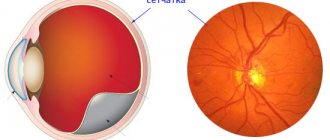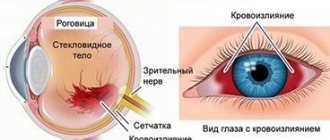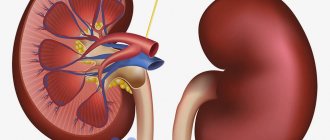Retinal angiopathy is an eye disease caused by changes in the vascular system of the organ of vision (capillaries and other vessels). The cause of this problem is disorders of the autonomic nervous system, which causes changes in the regulation of vascular tone. The resulting difficulties with blood circulation in the ocular media (inflow and outflow) disrupt their normal function and lead to serious visual impairment.
Problems with the blood vessels of the eye are not independent diseases, but arise against the background of other malfunctions of the body. Simply put, retinal angiopathy occurs as a result of problems with the blood vessels of the entire body. Pathological changes affecting the vascular system of the body also affect the vessels of the eyes, including the capillaries of the retina. Therefore, the term “angiopathy,” meaning vascular damage in various systemic diseases, is fully applicable to the vessels of the retina.
This dysfunction can affect people of any age and has no sex “preference.” It can be diagnosed in both children and adult men and women. And yet, some patterns of its occurrence exist. Thus, retinal angiopathy is more susceptible to people after 30 years of age, and not to a very young or young age. The disease, with rare exceptions, occurs simultaneously in both eyes.
Diagnostic examination to detect retinal angiopathy includes ophthalmoscopy, ultrasound of the eyes, as well as FA with the introduction of a contrast agent OCT or MRI of the eyes. In this case, ophthalmoscopy reveals vascular changes in the fundus with disturbances in the lumens or passages: the vessels are narrowed or dilated, tortuous, with excessive or weak filling. To detail the process and determine the speed of blood flow, the rest of the above studies are prescribed.
In the absence of timely and adequate treatment, retinal angiopathy becomes the cause of glaucoma and cataracts. In advanced forms, it can lead to serious vision impairment and even blindness.
Classification of eye angiopathy
Forms of retinal angiopathy are usually distinguished according to the diseases and conditions that caused its occurrence. Thus, the international classification of pathology includes:
Diabetic form . In this case, damage to blood vessels occurs due to decompensated diabetes mellitus, whose manifestations affect the speed of blood circulation, slowing it down and worsening vision function.
Hypertonic form . It occurs with long-term, severe hypertension and is manifested by strong tortuosity and branching of the veins of the fundus, with their expansion and frequent pinpoint hemorrhages into the ocular media, which leads to clouding of the latter. Proper treatment of hypertension leads to spontaneous regression of retinal angiopathy.
Hypotonic form . It is expressed by a decrease in the tone of the smallest capillaries of the retina, which leads to overflow of blood vessels and veins, provoking thrombus formation. Patients with this form of the disease feel a pulsation in the eyes, especially with eyestrain.
Traumatic form . The development of this form of angiopathy provokes traumatic injury to the cervical spine, brain, or severe compression of the chest. The cause of angiopathy in this case is compression of the blood vessels of the cervical spine and a sharp jump in a person’s intracranial pressure.
Youth uniform . This form of angiopathy is considered the most unfavorable, and the specific causes of its occurrence have not yet been studied. The most common manifestations of juvenile angiopathy are processes of inflammation in the vessels of the eyes, hemorrhages in the retina and vitreous body, and the growth of connective tissue on the retina. Often, juvenile angiopathy provokes the formation of cataracts, glaucoma, and causes retinal detachment.
Angiopathy: so different, so dangerous
What is meant by diagnosis
Angiopathy is a pathological condition of blood vessels in which the tone or structure of the vascular wall changes.
It occurs in various diseases, including as a dangerous complication. There are the following main types:
- Diabetic
- Amyloid cerebral
- Retinal angiopathy
Less common are hypertensive, hypotonic, traumatic, striatal (newborns). Each has its own characteristics in diagnosis, course, causes and therapy.
The disease affects both small blood vessels (then we are talking about microangiopathy) and large ones. Angiopathy of the arteries usually develops in the lower extremities, heart, brain and is severe. Macroangiopathy is usually caused by diabetes and atherosclerosis.
Causes
The occurrence of retinal angiopathy can be due to a number of reasons, these include:
- Osteochondrosis of the cervical spine.
- Eye injuries.
- Persistent increase in intracranial pressure.
- Dysfunction of the autonomic nervous system in the regulation of vascular wall tone.
- Some blood diseases.
- Decompensated diabetes mellitus.
- Arterial hypertension.
- Intoxication damage to the body.
- Genetic abnormalities in the structure of the vascular wall, for example, telangiectasia.
- Senile age and the irreversible changes it causes in the body.
- Smoking.
- Work in hazardous industries.
- Autoimmune systemic diseases, for example, vasculitis.
Summarizing the above list, we can say that problems with retinal vessels are caused by eye injuries, systemic vascular diseases, as well as systemic metabolic and autoimmune pathologies.
An important role is also played by intoxication of the body caused by heavy metals, toxic substances, etc.
Development of angiopathy during pregnancy
This is a common phenomenon that occurs in both new and experienced mothers during the second or third semester. In most cases, the disease appears towards the end of pregnancy.
The appearance of retinal angiodystonia is associated with high blood pressure, atherosclerosis or diabetes mellitus. As the embryo grows, blood volume increases, pressure jumps (especially in a stressful situation), which causes the vascular walls to stretch. As a result, the risk of thrombosis, hemorrhage, retinal detachment, and blindness increases.
It is worth highlighting the characteristic differences of hypertensive angiopathy during pregnancy:
- Periodic narrowing of the arteries. The cause is toxicosis.
- Sclerosis of blood vessels.
- Impaired blood circulation.
- The visual system recovers quickly after the birth of a child.
If such a pathological condition develops during pregnancy, the doctor may prescribe a planned cesarean section. Natural childbirth can cause retinal vessels to rupture, and a woman can completely lose her vision.
Manifestations of retinal angiopathy
Ophthalmologists include signs of retinal angiopathy:
- Gradual deterioration in the quality of vision.
- Cloudiness of visible objects, fogginess, veils before the eyes.
- Periodic nosebleeds.
- Pinpoint hemorrhages inside the eye.
- Progression of myopia.
- Degenerative changes in the retina.
- Appearance of floaters and dark spots before the eyes.
- Periodic appearance of light flashes and lightning before the eyes.
- Discomfort and pain in the eyes, especially with visual fatigue.
Retinal angiopathy is especially dangerous due to its consequences. They are caused by a disruption of the normal function of the eye caused by changes in the blood supply and nutrition of the ocular media. Deterioration of blood circulation in the vascular bed leads to its stagnation and the risk of thrombosis. The eye structures experience hypoxia from lack of oxygen and do not receive enough nutrients. Decomposition products are not regularly removed through the bloodstream, which causes persistent intoxication.
In this regard, patients with retinal angiopathy very often have concomitant diseases of the visual organ:
- Progressive myopia.
- Cataract.
- Retinal dystrophy.
- Glaucoma.
- Retinal detachments.
- In addition, in the long term, retinal angiopathy can lead to blindness in one or both eyes.
List of used literature
- Babaeva A.R., Tarasov A.A., Davydov S.I., Emelyanova A.L. // Bulletin of VolSMU. - 2006. - T. 19, No. 3. - P. 18-23.
- Voskanyants A. N., Nagornev V. A. // Cytokines and inflammation. - 2004. - T. 3, No. 4. - P. 10-13.
- Gurevich V.S. // Diseases of the heart and blood vessels. - 2006. - No. 4. - P. 4-8.
- Demyanov A.V., Kotov A.Yu., Simbirtsev A.S. // Cytokines and inflammation. - 2003. - T. 2, No. 3. - P. 20-35.
- Dedov I.I., Aleksandrov A.A. // Consilium med. — 2004. —T. 6, No. 9. - P. 620-624.
- Dedov I. I., Antsiferov M. B., Galstyan G. R., Tokmakova A. Yu. Diabetic foot syndrome. — M.: Federal Diabetology Center of the Ministry of Health of the Russian Federation, 1998
Diagnostics
Diagnosis of angiopathy is very important, so it is better to trust it only to a qualified ophthalmologist. The first step is collecting a complete medical history. An ophthalmological examination is then prescribed.
To examine the retina of the eye, ophthalmoscopy is prescribed. In order to clarify the details of the disease, additional examination methods are used: x-ray and ultrasound examinations. Thus, ultrasound scanning helps determine the speed of blood flow in the vessels of the retina and the current state of the vascular wall. An X-ray examination, performed with the use of a contrast agent, is prescribed to determine the patency of blood vessels.
In some cases, the doctor may recommend magnetic resonance imaging to clarify details in the structure and condition of the soft tissues of the ocular media.
Cost of treatment at the Santa Clinic
The price for treatment of angiopathy is determined depending on the chosen method of therapy. The exact cost can be found out after receiving the results of the analysis and examination by an ophthalmologist.
The Santa Clinic practices various methods of treating angiopathy. Experienced surgeons successfully perform laser coagulation operations. Previously, the patient is completely examined using hardware techniques. If concomitant pathologies are identified, consultation with specialists will be required.
To make an appointment please call. Operators will choose a convenient time for you to visit.
Prevention of pathology
To prevent the symptoms of retinal angiopathy, it is first of all necessary to undergo regular medical examinations in order to timely identify and treat diseases that cause this dysfunction.
In addition, the following simple rules will help prolong eye health:
- Create correct, sufficient lighting of the workplace.
- Do not read in transport when shaking and at home while lying down in poor lighting.
- When working at a computer for a long time, be sure to take breaks for eye exercises. Ideally, work at the monitor will be forty-five minutes, and rest from it will be fifteen minutes.
- When working visually for a long time, you need to give your eyes a rest - lie on your back, close your eyes and completely relax. If you can't lie down, you can simply lean back in your chair and close your eyes.
- Massaging the eyes with your fingertips is very useful.
- It is worth monitoring your blood pressure, taking timely measures to reduce it. Do physical exercise regularly, walk outside, do breathing exercises, walk more, create a diet rich in foods that strengthen the vascular wall.
- Check your blood sugar levels twice a year.
- Limit the amount of sweet, starchy, fatty, salty and spicy foods in your diet, as well as fried foods and alcohol.
- When planning pregnancy, carry out complete prophylaxis of the body to eliminate foci of chronic infection (caries, tonsillitis and other chronic diseases).
- Annually undergo preventive treatment of diabetes mellitus, hypertension, osteochondrosis with complex therapy, including taking Actovegin, Vinpocetine, Trental, ATP, as well as B vitamins.
Disease prognosis
The prognosis for the outcome of retinal angiopathy is directly related to the cause of this complication. In addition, it is worth considering the stage of the pathological process.
If diabetes mellitus is compensated and blood glucose levels are maintained within normal limits, the condition of the retina stabilizes and vascular disorders do not progress.
The progression of the hypertensive form of retinal angiopathy stops with stabilization of blood pressure and subsequent healthy lifestyle, which makes it possible to minimize the manifestations of the underlying disease.
In the case of a traumatic form of pathology, the consequences of the injury should be treated, and then periodically undergo vascular therapy to maintain the result. In this case, the eye condition will improve and angiopathy will stop progressing.
To stop the progression of the hypotonic form of angiopathy, it is important to take measures to increase blood pressure and maintain it at the proper level.
And only the juvenile form of retinal angiopathy is prone to constant progression. Although it can be significantly slowed down by using regular complex therapy, following the recommendations of specialists and maintaining a healthy lifestyle.
If adequate measures are not taken to treat the underlying disease and maintain normal vascular tone, a person faces constantly progressive myopia, sometimes to the point of complete loss of vision.
With timely treatment of the mild and middle stages of the underlying disease, retinal angiopathy can be completely eliminated and the quality of vision can be restored.
A vascular complication aggravated by pregnancy can lead to deterioration of visual acuity. Moreover, it can be completely lost during childbirth. However, it is important to know that a healthy lifestyle of a pregnant woman, proper preparation for childbirth, a confident psychological attitude and the right behavior during the delivery process help maintain vision at the level observed before conception. Expectant mothers need to learn techniques for relaxing and releasing muscle tension during childbirth so that labor takes place with minimal pain and no serious strain on the eye vessels. If this does not happen, in order to avoid serious consequences, you should agree to a cesarean section.
In the vast majority of women in labor, the symptoms of angiopathy gradually disappear spontaneously. And only some require subsequent special treatment.
The diagnosis of retinal angiopathy in newborns is often made incorrectly. Since when the child reaches one year of age, it is removed completely.
Timely therapeutic measures taken in the childhood form of the disease most often eliminate the problem completely and vision is restored.
Treatment
Understanding that retinal angiopathy is a consequence of a systemic disease, to treat it, it is necessary to eliminate the underlying pathology. With hypertensive angiopathy, the leading role in treatment belongs to normalizing blood pressure and reducing blood cholesterol levels. To treat diabetic angiopathy, in addition to previously prescribed glucose-lowering drugs, a mandatory special diet is added, which excludes foods high in carbohydrates from the diet. Moderate physical activity is also useful, as it can support the functioning of the heart and blood vessels.
To alleviate the condition of the blood vessels of the eyes, drugs that normalize blood circulation are indicated: pentilin, trental, vasonite, solcoseryl, arbiflex, emoxipine, etc. The listed drugs improve the bendability of red blood cells, which ensures activation of blood flow in the capillaries. Patients with fragile blood vessels are recommended to take calcium dobesilate. This drug thins the blood, improves its circulation in the vessels, and normalizes the permeability of the vascular walls.
Treatment of retinal angiopathy involves the use of physiotherapeutic methods: magnetic therapy, acupuncture and laser exposure. These procedures can improve the general condition of the patient.
Retinal angiopathy is a reversible side condition that many are not inclined to take seriously. And yet, in an advanced form without adequate treatment of the underlying disease, it leads to severe deterioration of vision or even its complete loss.
Military service for patients with retinal angiopathy
The diagnosis of retinal angiopathy for young people of military age cannot be considered as a reason not to serve. Mild degrees of this pathology do not imply exclusion from military service, since there are no completely healthy people in the armed forces or there are very few of them.
In some cases, physical and psychological stress caused by combat service will not worsen the conscript’s eye condition. Therefore, in each specific case, the decision on conscription is made by the medical commission at the military registration and enlistment office. At the same time, the nature and course of the disease that caused this complication, its stage and the risk of recurrence must be taken into account.
Retinal angiopathy, in most cases, is not a sentence to permanent loss of vision, with no chance of its successful restoration. It is best to contact an ophthalmologist in a timely manner if the above-described symptoms of this pathology appear and entrust your treatment to him. In this case, you can count on an improvement in the condition of the retina and a complete restoration of the quality of vision.
Useful video
More information can be found at the following links:
The eyes are a unique organ that requires close attention. The presence of angiopathy does not mean loss of vision. Parents' attention to their children is the key to their health.
Author's rating
Author of the article
Alexandrova O.M.
Articles written
2100
about the author
Was the article helpful?
Rate the material on a five-point scale!
( 1 ratings, average: 5.00 out of 5)
If you have any questions or want to share your opinion or experience, write a comment below.











